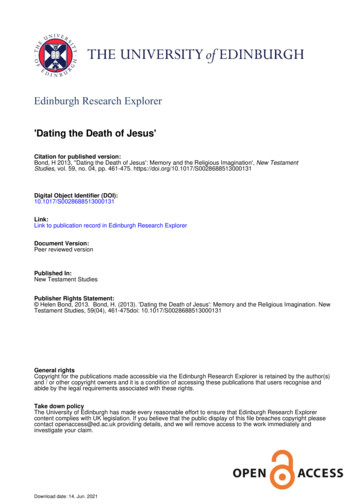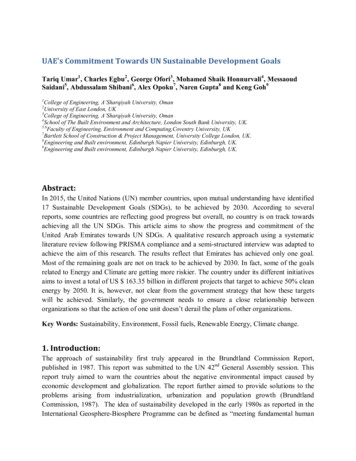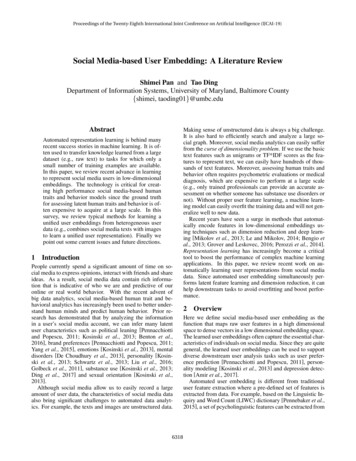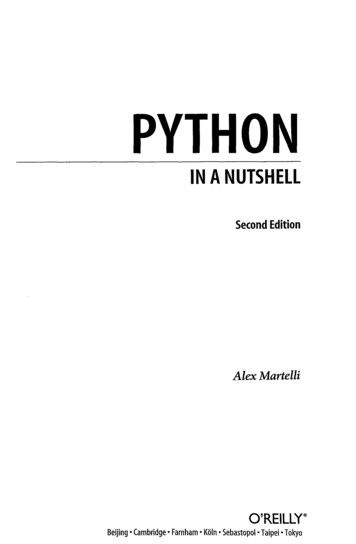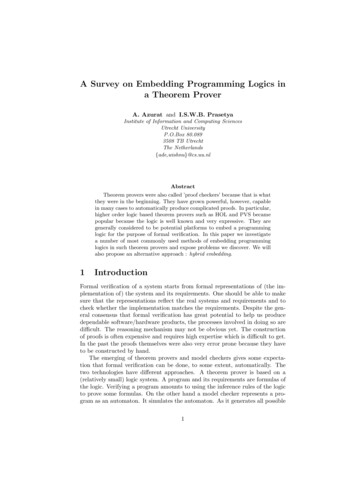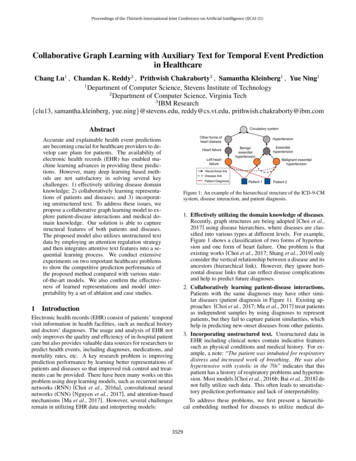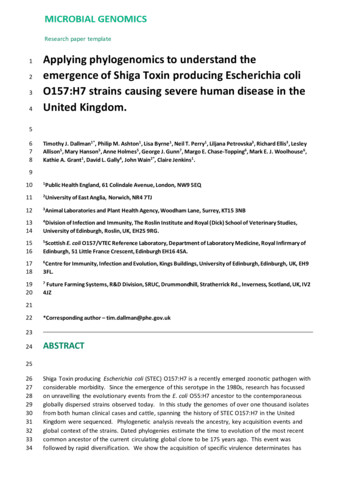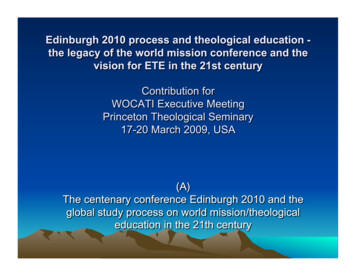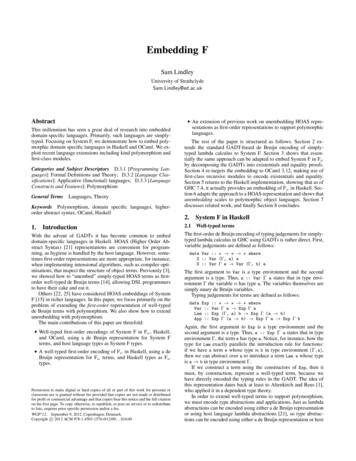
Transcription
Embedding FSam LindleyUniversity of StrathclydeSam.Lindley@ed.ac.ukAbstractThis millennium has seen a great deal of research into embeddeddomain-specific languages. Primarily, such languages are simplytyped. Focusing on System F, we demonstrate how to embed polymorphic domain specific languages in Haskell and OCaml. We exploit recent language extensions including kind polymorphism andfirst-class modules.Categories and Subject Descriptors D.3.1 [Programming Languages]: Formal Definitions and Theory; D.3.2 [Language Classifications]: Applicative (functional) languages; D.3.3 [LanguageConstructs and Features]: PolymorphismGeneral Terms Languages, TheoryKeywords Polymorphism, domain specific languages, higherorder abstract syntax, OCaml, Haskell1.IntroductionWith the advent of GADTs it has become common to embeddomain-specific languages in Haskell. HOAS (Higher Order Abstract Syntax) [21] representations are convenient for programming, as hygiene is handled by the host language. However, sometimes first-order representations are more appropriate, for instance,when implementing intensional algorithms, such as compiler optimisations, that inspect the structure of object terms. Previously [3],we showed how to “unembed” simply-typed HOAS terms as firstorder well-typed de Bruijn terms [14], allowing DSL programmersto have their cake and eat it.Others [22, 25] have considered HOAS embeddings of SystemF [15] in richer languages. In this paper, we focus primarily on theproblem of extending the first-order representation of well-typedde Bruijn terms with polymorphism. We also show how to extendunembedding with polymorphism.The main contributions of this paper are threefold: Well-typed first-order encodings of System F in Fω , Haskell,and OCaml, using a de Bruijn representation for System Fterms, and host language types as System F types. A well-typed first-order encoding of Fω in Haskell, using a deBruijn representation for Fω terms, and Haskell types as Fωtypes.Permission to make digital or hard copies of all or part of this work for personal orclassroom use is granted without fee provided that copies are not made or distributedfor profit or commercial advantage and that copies bear this notice and the full citationon the first page. To copy otherwise, to republish, to post on servers or to redistributeto lists, requires prior specific permission and/or a fee.WGP’12, September 9, 2012, Copenhagen, Denmark.Copyright c 2012 ACM 978-1-4503-1576-0/12/09. . . 10.00 An extension of previous work on unembedding HOAS repre-sentations as first-order representations to support polymorphiclanguages.The rest of the paper is structured as follows. Section 2 extends the standard GADT-based de Bruijn encoding of simplytyped lambda calculus to System F. Section 3 shows that essentially the same approach can be adapted to embed System F in Fωby decomposing the GADTs into existentials and equality proofs.Section 4 re-targets the embedding to OCaml 3.12, making use offirst-class recursive modules to encode existentials and equality.Section 5 returns to the Haskell implementation, showing that as ofGHC 7.4, it actually provides an embedding of Fω in Haskell. Section 6 adapts the approach to a HOAS representation and shows thatunembedding scales to polymorphic object languages. Section 7discusses related work, and finally Section 8 concludes.2.System F in Haskell2.1Well-typed termsThe first-order de Bruijn encoding of typing judgements for simplytyped lambda calculus in GHC using GADTs is rather direct. First,variable judgements are defined as follows:data Var :: ? ? ? whereZ :: Var (Γ, a) aS :: Var Γ a Var (Γ, b) aThe first argument to Var is a type environment and the secondargument is a type. Thus, n :: Var Γ a states that in type environment Γ the variable n has type a. The variables themselves aresimply unary de Bruijn variables.Typing judgements for terms are defined as follows:data ExpVar ::Lam ::App :::: ? ? ? whereVar Γ a Exp Γ aExp (Γ, a) b Exp Γ (a b)Exp Γ (a b) Exp Γ a Exp Γ bAgain, the first argument to Exp is a type environment and thesecond argument is a type. Thus, e :: Exp Γ a states that in typeenvironment Γ, the term e has type a. Notice, for instance, how thetype for Lam exactly parallels the introduction rule for functions:if we have a term e whose type is b in type environment (Γ, a),then we can abstract over a to introduce a term Lam e whose typeis a b in type environment Γ.If we construct a term using the constructors of Exp, then itmust, by construction, represent a well-typed term, because wehave directly encoded the typing rules in the GADT. The idea ofthis representation dates back at least to Altenkirch and Reus [1],who applied it in a dependent type theory.In order to extend well-typed terms to support polymorphism,we must encode type abstractions and applications. Just as lambdaabstractions can be encoded using either a de Bruijn representationor using host language lambda abstractions [21], so type abstractions can be encoded using either a de Bruijn representation or host
language polymorphism. In this paper we explore the latter option,aiming to choose an encoding of object types that is as close aspossible to the equivalent host language types.2.2PolymorphismLet us try to extend the Exp type to include type lambda and typeapplication expressions. This amounts to encoding the introductionand elimination rules for universal quantification. The introductionrule is:Γ M :Aα / FTV (Γ)Γ (Λα.M ) : α.ANote that the type A may contain the type variable α. We can modelthis property by representing A as a type constructor applied to aHaskell type variable. But we need to be careful to appropriatelyquantify over the Haskell type variable:TLam :: ( a.Exp Γ (k a)) Exp Γ ( a.k a)For the premise we quantify over a outside the Exp type constructor;for the conclusion, we quantify over a inside the Exp type constructor. This is all well and good, but unfortunately Haskell does notplay well with GADTs indexed by polymorphic types. It is possible to work around this problem by hand-coding GADTs usingLeibniz equality and enabling the ImpredicativeTypes languageextension. However, doing so requires some effort, and type inference in this setting is rather fragile. A more robust work-around isto define a newtype for boxing the polymorphism, which eases thejob that type inference must perform:The identity function Lam (Var Z) has type Exp (a - a), but weneed to inject it into the type forall a.Exp (AtoA a) before passing it as an argument to TLam. Correspondingly, after instantiating the polymorphic identity function at a particular type, we mustproject from the boxed type before we can apply it to an argument.2.3class Iso a b whereinject :: a bproject :: b ainstance Iso a a whereinject x xproject x xThe special newtype deriving mechanism of GHC allows suitableinstances to be derived semi-automatically from the canonical instance for Iso a a.Let us add a deriving clause to AtoA:newtype AtoA a AtoA { unAtoA :: a a }deriving (Iso (a a))This clause automatically derives the functions:inject :: (a a) AtoA ainject x AtoA (inject x)project :: AtoA (a a)project x unAtoA (project x)newtype Poly k Poly {unPoly :: a.k a}Now, we have:TLam :: ( a.Exp Γ (k a)) Exp Γ (Poly k)The elimination rule for polymorphism is:Γ M : α.AΓ M B : A[B/α]We again use the Poly constructor for the polymorphic type in thepremise, while the substitution in the conclusion is implementedsimply by applying the type constructor:TApp :: Exp Γ (Poly k) Exp Γ (k a)The data type for expressions becomes:data Exp :: ? ? ? whereVar :: Var Γ a Exp Γ aLam :: Exp (Γ, a) b Exp Γ (a b)App :: Exp Γ (a b) Exp Γ a Exp Γ bTLam :: ( a.Exp Γ (k a)) Exp Γ (Poly k)TApp :: Exp Γ (Poly k) Exp Γ (k a)GHC is happy to accept this, but we still have a problem. Lookcarefully at the types, and it becomes clear that it is impossibleto actually construct any interesting TLam expressions because theonly way of constructing an expression of type k a is as a variable(which admits any type at all). The only other possibility would bea type application, but that requires us to have already constructeda polymorphic expression using TLam.The problem is that Haskell type constructors are second-classcitizens. We must define them as newtypes, and then we need toexplicitly box and unbox values to and from the newtype. For instance, suppose we wish to define the polymorphic identity function. We first define a type constructor of the appropriate type:newtype AtoA a AtoA { unAtoA :: a a }Deriving isomorphismsIn order to coordinate injection and projection we define a typeclass representing the isomorphism between newtypes and theirrepresentations.As newtypes are unboxed in the backend, both inject and projectare actually realised as the identity function.Now we add constructors for injection and projection to ourexpression type:data Exp :: ? ? ? whereVar:: Var Γ a Exp Γ aLam:: Exp (Γ, a) b Exp Γ (a b)App:: Exp Γ (a b) Exp Γ a Exp Γ bTLam:: ( a.Exp Γ (k a)) Exp Γ (Poly k)TApp:: Exp Γ (Poly k) Exp Γ (k a)Inject :: Iso a b Exp Γ a Exp Γ bProject :: Iso a b Exp Γ b Exp Γ aFinally, we add wrappers for Inject and Project.inj :: Iso a b (a b) Exp Γ a Exp Γ binj Injectproj :: Iso a b (a b) Exp Γ b Exp Γ aproj ProjectThe first argument for each is a proxy used to aid type inference. Inboth cases it will always be a newtype constructor.2.4ExamplesWe define the polymorphic identity function as follows:id poly :: Exp () (Poly AtoA)id poly TLam (inj AtoA (Lam (Var Z)))and instantiate it at a concrete type:id int :: Exp () (Int Int)id int proj AtoA (TApp id poly)We can now use polymorphism wherever we like. We just needto define an appropriate newtype including a deriving (Iso .)clause, inject into the newtype before using TLam, and project fromit after using TApp.
It is tempting to try to define a function tlam TLam . inj.Unfortunately, GHC cannot infer a type for such a function, and itdoes not appear possible to explicitly assign it a type either. Thesame problem occurs when trying to combine TApp and proj.In use, the embedded object language we have developed is notquite the same as System F, but it is equivalent — our language differs only in the way that types are abstracted and applied in terms.We do not need to annotate lambdas with their inputs as GHC infers them for us. For type abstractions, rather than providing a typevariable, we provide a description of the polymorphic type in theform of a type constructor into which we inject the body of thetype abstraction. For type applications, instead of providing a type,we again provide the type constructor, from which we project aconcrete instantiation of a polymorphic term. The resulting presentation of System F is similar to Russo and Vytniotis’s QML language [27], which extends ML with System F polymorphism.The need to define a new type constructor for each polymorphic type is inconvenient, but it seems unavoidable given that typeconstructors are not first-class in Haskell.2.5Nested quantifiersIn Haskell, newtypes can only be defined at the top-level. Thismeans that if a type variable from an outer quantifier appears inside a polymorphic type then we need to define a multi-parametertype constructor. For instance, here is how we define the K combinator, which takes two arguments, ignores the first and returns thesecond:newtype KC’ a b KC’ { unKC’ :: a b a }deriving (Iso (a b a))newtype KC a KC { unKC :: Poly (KC’ a) }deriving (Iso (Poly (KC’ a)))kc :: Exp () (Poly KC)kc TLam (inj KC(TLam (inj KC’ (Lam (Lam (Var (S Z)))))))2.6An evaluatorIn order to test that our implementation is at least somewhat sensible, we provide an implementation of an evaluator.data Env :: ? ? whereEmpty :: Env ()Extend :: Env Γ a Env (Γ, a)lookupVar :: Env Γ Var Γ a alookupVar (Extend v)Z vlookupVar (Extend env ) (S n) lookupVar env nevalevalevalevalevalevalevaleval:: Env Γ Expenv (Var x)env (Lam e)env (App f a)env (TLam e)env (TApp e)env (Inject e)env (Project e)Γ a alookupVar env xλv (eval (Extend env v) e)eval env f eval env aPoly (eval env e)unPoly (eval env e)inject (eval env e)project (eval env e)The cases for variables, lambdas and applications are standard. Theother cases just deal with the necessary boxing and unboxing ofnewtypes.As a trivial example, let us instantiate the identity function attype Int:id int :: Exp () (Int Int)id int proj AtoA (TApp id poly)If we now do eval Empty id int 42, then GHC returns 42 asexpected.(kinds)K :: ? K K(types)A, B :: α A B αK .A λαK .A A B(terms)e, f :: x λxA .e e f ΛαK .e e A(environments) Γ, :: · Γ, α : K Γ, x : AFigure 1. Fω syntax3.System F in FωHaving developed an embedding of System F in Haskell, we nowshow that the same idea can be adapted to embed System F in Fωby translating away the GADTs into existential types and type-levelequality coercions. Though Fω does not have GADTs, it does havefirst-class type constructors in the form of lambda abstractions atthe level of types, which do make life considerably easier. In thenext Section we use the embedding in Fω as inspiration for anembedding in OCaml using recursive first-class modules.The syntax of Fω is given in Figure 1. The typing rules andreduction rules for System F and Fω can be found in standardtextbooks (e.g. [15, 24]).3.1Syntactic sugarWe assume standard encodings of n-ary lambdas (A1 · · · An B), products (A1 · · · An ), sums (A1 · · · KnAn ), and universal quantifiers ( α1K1 . . . αn.A). In addition,we assume a standard encoding of n-ary existential quantifiersKn( α1K1 . . . αn.A) in terms of universal quantifiers, and the following sugar for using n-ary existentials. .A A α1 . . . αn .A α1 . α2 . . . αn .Apack []e as B epack [A1 . . . An ]e as B pack [A1 ](pack [A2 . . . An ]e as B 0 ) as Bwhere B α1 .B 0 and B 0 α2 . . . αn .B 00unpack e as []x in e0 e0 [e/x]unpack e as [α1 , . . . , αm ]x in e0 unpack e as [α1 ]z1 in unpack z1 as [α2 , . . . , αm ]zm in [zm /x]where z1 , . . . , zm are not free in e0injk [α1 . . . αm ](x1 , . . . , xn ) e injk y unpack y as [α1 , . . . , αm ]z ine[proj1 z/x1 , . . . , projm z/xn ]where x and y are not free in e3.2Leibniz equalityIn order to simulate GADTs in Fω , we must encode type-levelequality constraints. Leibniz equality is expressed in Fω as the type α β φ? ? ? .φ α φ β (see, e.g., [4]). The intuition is that if thetypes bound to α and β are equal then they should be equal in anycontext, where a context is exactly a type constructor φ? ? ? .Figure 2 defines Leibniz equality. We write Eq A B for the typeof proofs that type A and type B are equal. We write refl A (reflexivity) for the proof that type A is equal to itself, and cast A B p forthe function that uses equality proof p of type Eq A B to convertany value of type A to the same value at type B. (It is also straightforward to define functions for symmetry and transitivity, but theyare not necessary here.)3.3The embeddingTo simplify the presentation, we will assume that our version ofFω has been extended with recursive types, and define our type
Eq :: ? ? ?Eq λα β. φ? ? .φ α φ βrefl : α.Eq α αrefl Λα φ? ? .λxφ α .xcast : α β.Eq α β α βcast Λα β.λpEq α β xα .p (λγ.γ) xFigure 2. Type equality in Fωlookup : Γ α.Γ Var Γ α αlookup ΛΓ α.λenv Γ nVar Γ α .case n of inj1 [ ](p) proj2 (cast p env )inj2 [ β](p, n) lookup (proj1 (cast p env )) neval : Γ α.Γ Exp Γ α αeval ΛΓ α.λenv Γ eExp Γ α .case e of inj1 n lookup env ninj2 [β γ](p, b) cast p (λv β .eval (env , v) b)inj3 [β](f, a) (eval env f ) (eval env a)inj4 [φ? ? ](p, b) cast p (Λβ.eval env (b β))inj5 [β φ? ? ](p, e) cast p ((eval env e) β)Z, S :: ? ? ?Z λΓ α. . Eq Γ ( α)S λΓ α. β. Eq Γ ( β) Var αVar , Lam, App, TLam, TApp :: ? ? ?Var λΓ α. Z Γ α S Γ αLam λΓ α. β γ.Eq (β γ) α Exp (Γ β) γApp λΓ α. β.Exp Γ (β α) Exp Γ βTLam λΓ α. φ? ? . Eq ( β.φ β) α ( β.Exp Γ (φ β))TApp λΓ α. β φ? ? . Eq (φ β) α Exp Γ ( γ.φ γ)Exp :: ? ? ?Exp λΓ α.Var Γ α Lam Γ α App Γ α TLam Γ α TApp Γ αFigure 3. Embedding System F in FωFigure 4. An evaluator for System F in Fω(types)A, B :: α A B α.A(variables)n :: z s n(terms)M, N :: n λA .M M N Λα.M M A(environments) Γ, :: · Γ, AFigure 5. System F de Bruijn syntaxrepresenting well-formed environments. This works for our usecase, and indeed we could have done the same for the Haskellimplementation. It does not, however, seem possible to realise afaithful representation of the Env GADT from the Haskell implementation in the Fω version. This is due to a well-known limitationof the Leibniz encoding of GADTs, which is unable to capture theinjectivity of GADTs [11]. (Essentially the problem is that the typesystem is unable to capture the property that φ A φ B impliesthat A B.)The other main difference from the Haskell evaluator is that wemust explicitly apply the equality proofs using the cast function.constructors mutually recursively using a Scott encoding [18]. Theembedding is given in Figure 3.For variables we have type constructors Z and S. For Z Γ α,we just need to provide a proof that the first element of Γ is α,that is, a proof that there exists an environment , such that Γis equal to ( α). For S Γ α, we must provide a proof that Γis non-empty, along with a variable that can be typed by the tailof Γ. These type constructors are really just the same as those inthe Haskell implementation. The key difference is that the implicitequality proofs provided by the GADT representation have had tobe made explicit.The type constructors for expressions follow a similar pattern.The Var constructor just dispatches to S and Z. The Lam constructor existentially quantifies over the argument and result typesand includes a proof that they combine to form the type of theresulting expression. The App constructor existentially quantifiesover the function argument type. Both TLam and TApp existentially quantify over the type constructor φ that is used to encodea universal quantifier. The TApp constructor additionally existentially quantifies over the type argument. Apart from the existentialquantification and equality proofs, the embedding is essentially thesame as the Haskell implementation, and can equally well be readas a fairly direct transcription of the typing rules for System F.The Exp constructor gathers together all of the expression constructors into a single sum type.For System F we use a de Bruijn representation, whereas for Fω weuse variable names. The syntax of our de Bruijn representation ofSystem F is given in Figure 5.We now define a function for embedding System F typingjudgements in Fω , and give a soundness result. The function J Kmaps System F typing judgements (Γ F M : A) to Fω typingjudgements (Γ Fω e : A). (Note that J K is a meta-level function defined outside of either language.) The auxiliary System Fjudgement Γ 3F n : A states that in type environment Γ de Bruijnvariable n has type A.Informally, the soundness result we seek should state that ifwe evaluate an embedded System F term, then the result is βηconvertible to the lifting of the System F term to the equivalent Fωterm. Thus, as well as the embedding function J K, we also need todefine a function d e to lift a de Bruijn representation of a SystemF term to a standard Barendregt-style representation of an Fω term.The embedding and lifting functions are defined in Figure 6.We write Γ Fω e f : A if Γ Fω e : A, Γ Fω f : A and eis βη-convertible to f .3.4T HEOREM 1 (Soundness).An evaluatorAssuming we have recursive functions (which we can define anyway once we have recursive types), we can write an evaluatorfor our System F embedding in Fω , which is again similar to theHaskell implementation. The evaluator is given in Figure 4. Weomit the evident type arguments for readability. A key difference isthat the environment is just Γ rather than the encoding of a GADT3.5Soundness of the embedding1. If Fω env : Γ and Γ 3F n : A, then Fω lookup Γ A env JΓ 3F n : AK dneenv : A2. If Fω env : Γ and Γ F M : A, then Fω eval Γ A env JΓ F M : AK dM eenv : A
JΓ 3F AK : Var Γ AJΓ, A 3F z : AK inj1 (pack [Γ](refl (Γ A)) as Z (Γ A) A)JΓ, A 3F s n : BK inj2 (pack [Γ A](refl (Γ A), JΓ 3F n : BK) as S (Γ A) B)JΓ F AK : Exp Γ AJΓ, A F n : AK inj1 (JΓ, A 3F n : AK)JΓ F λA .M : A BK inj2 (pack [A B](refl (A B), JΓ, A F M : BK) as Lam Γ (A B))JΓ F M A B N : BK inj3 (pack [A](JΓ F M : A BK, JΓ F N : AK) as App Γ B)JΓ F Λα.M : α.AK inj4 (pack [ α.A](refl ( α.A), Λα.JΓ F M : AK) as TLam Γ ( α.A))0JΓ F M α.B A : BK inj5 (pack [A (λα.B 0 )](refl B, JΓ F M : α.B 0 K) as TApp Γ B)dzeenv proj2 envds neenv dne(proj1 env )dM e dM e()dλA .M eenvdM N eenvdΛα.M eenvdM Aeenv λxA .dM e(env ,x) , dM eenv dN eenv Λα.dM eenv dM eenv Ax freshFigure 6. The embedding and lifting functionsThe proof is by induction on the structure of derivations.C OROLLARY 2. If F M : A, then Fω eval Γ A () J F M : AK dM e : A4.System F in OCamlWe will now show that the whole development can be redonein OCaml. Mostly this makes the implementation more painful,primarily because the current version of OCaml 3.12.1 does notsupport GADTs and module syntax can be somewhat heavyweightas a way for implementing existentials. However, in at least oneway the implementation is a little cleaner. Unlike in GHC, OCamltype constructors do not have to be boxed. This means that theexpression language does not need to be extended with forms forinjection and projection.Our starting point is Yallop and Kiselyov’s encoding of GADTsin OCaml [29]. As we have already observed, GADTs are essentially just existential types with type-level equality coercions. Existentials can be encoded in OCaml using higher-rank universaltypes, which can be encoded using records, objects, or modules.We will, however, adopt a more direct encoding in terms of firstclass recursive modules. As we have already seen, equality conversions can be implemented using Leibniz equality, which is definable as soon as one has universal quantification over type constructors. Yallop and Kiselyov, implement Leibniz equality usingfirst-class modules.We will not repeat Yallop and Kiselyov’s development here, butinstead just include the interfaces we use. First we define a unarytype constructor:module type TyCon sig type ’a tc endAs modules are first-class in OCaml 3.12, we can treat this modulesignature as a first-class type.The signature for Leibniz equality is show in Figure 7. For ourpurposes we only need the equality type eq, the reflexivity axiomrefl, and the cast operation cast.We begin with the encoding of variable typing judgements,which is shown in Figure 8. The sub-modules Z and S each represents an existential. The existentially bound type variables arethose that are not bound in the var data type. The value components of the module define the body of the existential. For instancethe Z module represents the type .(Γ, α) eq. It uses Leibnizequality to encode a proof that there exists some such that Γ isequal to α.modulesig(* Astypetype EQ value of type (s, t) eq is a proof that typesand t are the same. *)(’a, ’b) eq(* The reflexivity axiom. *)val refl : unit (’a, ’a) eq(* Leibniz’s substitution axiom. *)module Subst (TC : TyCon) :sigval subst : (’a, ’b) eq (’a TC.tc, ’b TC.tc) eqend(* Given a proof that type s and type t are equal, wecan convert s to t. *)val cast : (’a, ’b) eq ’a ’bendFigure 7. Leibniz equality in OCamlmodule rec Var : sigmodule type Z sigtype Γtype atype val p : (Γ, * a) eqendmodule type S sigtype Γtype atype type bval p : (Γ, * b) eqval n : ( , a) Var.varendtype (’Γ,’a) var Z of (module Z with type Γ ’Γ and type a ’a) S of (module S with type Γ ’Γ and type a ’a)end Varopen VarFigure 8. De Bruijn variables in OCaml
let z : ’Γ ’a . unit (’Γ * ’a, ’a) var fun (type ’) (type a’) () let module M structtype Γ ( ’ * a’)type a a’type ’let p refl()end inZ (module M : Var.Z withtype Γ ( ’ * a’) and type a a’)module rec Exp : sigmodule type LAM sigtype Γtype atype btype cval p : (b c, a) eqval e : (Γ * b, c) Exp.expendmodule type APP sigtype Γtype atype bval f : (Γ, b a) Exp.expval e : (Γ, b) Exp.expendlet s : ’ ’b ’a . (’ , ’a) var (’ * ’b, ’a) var fun (type ’) (type b’) (type a’) n’ let module M structtype Γ ( ’ * b’)type a a’type ’type b b’let p refl()let n n’end inS (module M : Var.S withtype Γ ( ’ * b’) and type a a’)module type TLAM sigtype Γtype atype ’b tcval p : (hpoly : ’b.’b tci, a) eqval e : hpoly : ’b.unit (Γ, ’b tc) Exp.expiendFigure 10. Smart constructors for de Bruijn variables in OCamlmodule type TAPP sigtype Γtype atype btype ’c tcval p : (b tc, a) eqval e : (Γ, hpoly : ’c.’c tci) Exp.expendtype (’Γ,’a) exp Var of (’Γ,’a) Lam of (module App of (module TLam of (module TApp of (moduleend peΓ ’ΓΓ ’ΓΓ ’ΓΓ ’ΓandandandandM.tlam {M.poly fun () lam (var (z()))}and we can specialise it to integers as follows:let id int : (unit, int int) exp let module M TA(AtoA) inM.tapp (id poly())typetypetypetypea ’a)a ’a)a ’a)a ’a)open ExpFigure 9. System F expressions in OCamlThe encoding of expressions (Figure 9) is similar. Polymorphictypes are boxed inside an object type similarly to the Poly newtypeused in the GHC implementation. Notice, however, that we create athunk for the body of a type abstraction. This is in order to preventthe ML value restriction from getting in the way of polymorphism.We choose objects here instead of records as being structural therefields do not pollute the global namespace.Before writing some examples, we first define some smart constructors (Figures 10 and 11). These allow us to invoke each nonpolymorphic syntax constructor without having to explicitly define a module, and to invoke each polymorphic syntax constructorthrough a module that defines the appropriate type constructor. Forthe polymorphic argument to TL.tlam we use a record instead ofan object as callers of the function will actually have to create thesevalues and record creation syntax is significantly more concise thanobject creation syntax.Now, consider the polymorphic identity function. Its type constructor is given by the module:module AtoA struct type ’a tc ’a ’a endWe write the polymorphic identity function as:let id poly () : (unit, hpoly : ’a.’a ’ai) exp let module M TL(AtoA) inNotice that although the syntax is not exactly concise, unlike inGHC we do not have to box and unbox type constructors: OCamlknows that ’a AtoA.tc is the same type as ’a ’a.Now let us consider the K combinator. As OCaml supportslocal module declarations, we need only ever define unary typeconstructors:let ck () :(unit, h poly : ’a.hpoly : ’b.’a ’b ’ai i) exp let module M TL(structtype ’a tc hpoly : ’b.’a ’b ’ai end) inM.tlam {M.poly fun (type a) () let module N TL(struct type ’b tc a ’b a end) inN.tlam {N.poly fun () lam(lam(var(s(z()))))}}Also note that we can inline functor parameters.We can write an evaluator for our OCaml implementation (Figure 12) that is essentially the same as the Fω one. The only realdifference is the boilerplate for managing modules and polymorphism.5.Fω in HaskellGHC 7.4 supports polymorphism over kinds. It turns out that thismeans our embedding of System F is actually an embedding of Fω .All we need to do is generalise the argument of Poly to operate overarbitrary kinds. In fact we do not need to change the code at all,we just need to enable the PolyKinds language extension. WithoutPolyKinds, the Poly constructor is assigned the type:Poly :: ( a. k a) Poly kWith PolyKinds enabled, it receives the mysterious type:Poly :: ( a. k a) Poly ? k
let rec lookup : ’Γ ’a . ’Γ (’Γ,’a) var ’a fun (type Γ) (type a) env function Z m let module M (val m : Z with type Γ Γ and type a a) insnd (cast M.p env) S m let module M (val m : S with type Γ Γ and type a a) inlookup (fst (cast M.p env)) M.nlet rec eval : ’Γ ’a . ’Γ (’Γ,’a) Exp.exp ’a fun (type Γ) (type a) env function Var n lookup env n Lam m let module M (val m : LAM with type Γ Γ and type a a) incast M.p (fun v eval (env, v) M.e) App m let module M (val m : APP with type Γ Γ and type a a) in(eval env M.f) (eval env M.e) TLam m let module M (val m : TLAM with type Γ Γ and type a a) in(cast M.p) (object method poly : ’b.’b M.tc eval env (M.e#poly ()) end) TApp m let module M (val m : TAPP with type Γ Γ and type a a) in(cast M.p) (eval env M.e)#polyFigure 12. System F evaluator in OCamlwhich indicates that the k type constructor is polymorphic. Currently there is no way for the programmer to assert that a kindshould be polymorphic, but GHC can infer this for itself.Given that we can embed Fω in GHC and we can embed SystemF in Fω , we could of course embed System F in the embedded Fω !As a simple example, let us just consider the basic interface toLeibniz equality. The type constructor is:newtype Leibniz a b (k :: ? ?) Leibniz { unLeibniz :: k a k b }deriving (Iso (k a k b))The definitions of refl and cast are straightforward:newtype Id a Id { unId :: a }deriving (Iso a)refl :: Exp () (Poly (Leibniz a a))refl TLam (inj Leibniz (Lam (Var Z)))cast :: Exp () (Poly (Leibniz a b) Id a Id b)cast Lam (proj Leibniz (TApp (Var Z)))Unfortunately, the definition of cast leaves us with some inconvenient Id constructors. We can eliminate them by η-expanding:cast’ :: Exp () (Poly (Leibniz a b) a b)cast’ Lam (Lam(proj Id (App (proj Leibniz (TApp (Var (S Z))))(inj Id (Var Z)
tends the standard GADT-based de Bruijn encoding of simply-typed lambda calculus to System F. Section 3 shows that essen-tially the same approach can be adapted to embed System F in F! by decomposing the GADTs into existentials and equality proofs. Section 4 re-targets the embedding to OCaml 3.12, making use of
